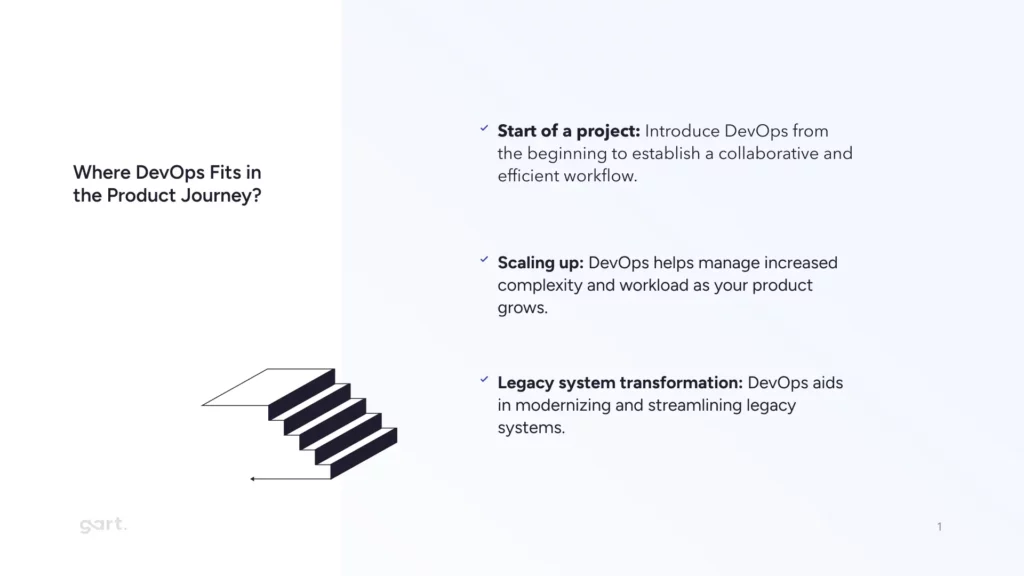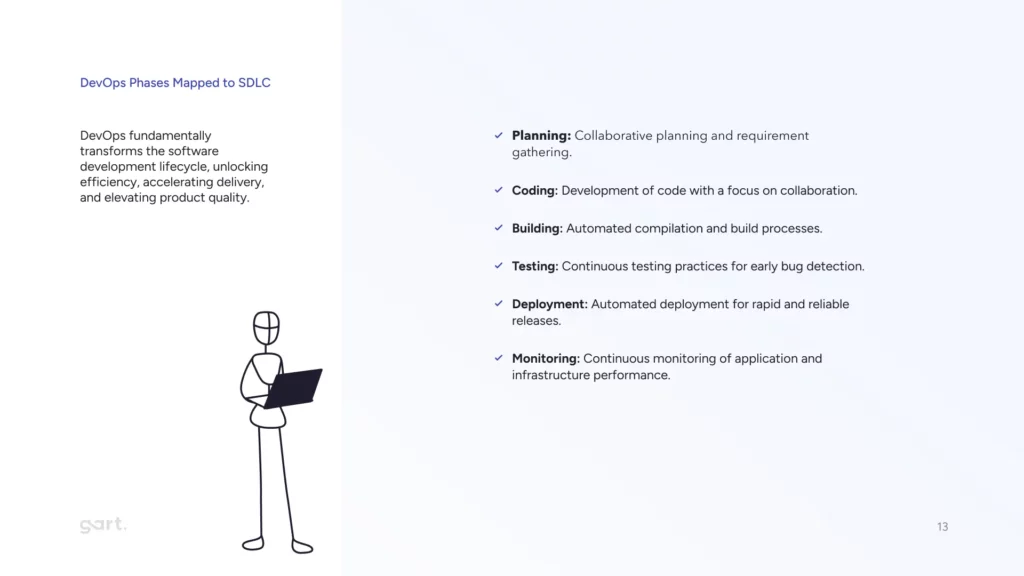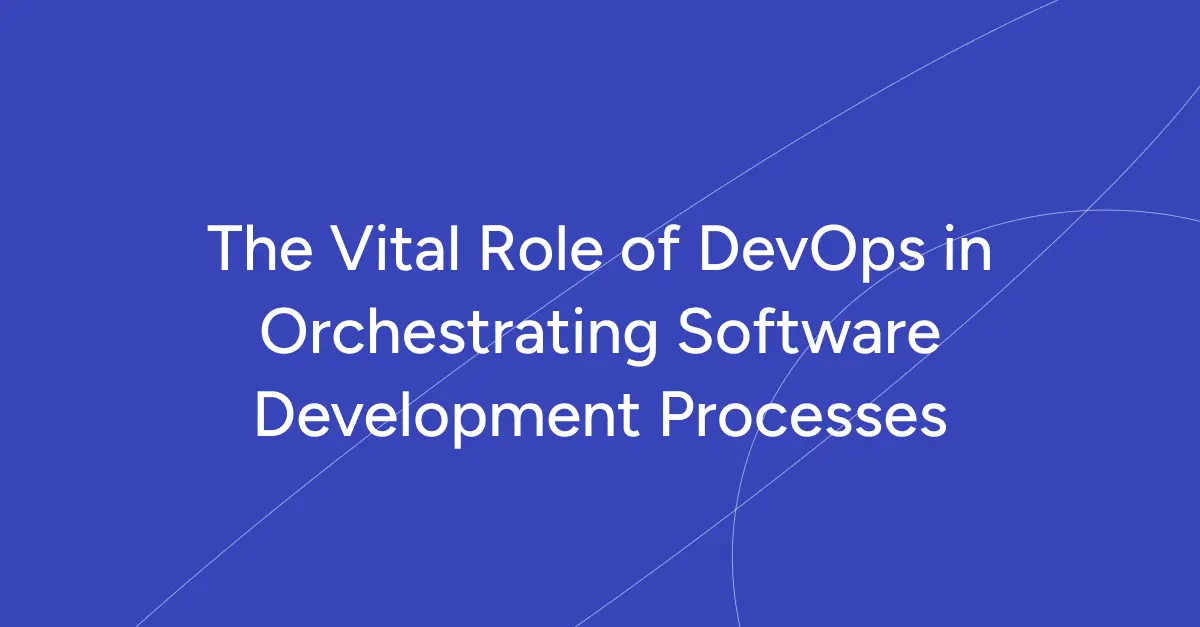In this article, I want to delve into the role of DevOps in the Software Development Life Cycle (SDLC) and explore how DevOps practices contribute to the creation of higher-quality products faster and even more cost-effectively.
So, at which stage of the product lifecycle do you need DevOps? Let’s try to unravel this.
Where DevOps Fits in the Product Journey?
It’s remarkable how DevOps expertise is essential both in the initial stages of product creation and during its scaling, as well as for process optimization or modernization.

Project Kickoff
Introduce DevOps from the very beginning to establish an efficient workflow. At this stage, DevOps helps foster collaboration between development and operations, promoting team cohesion and rapid product development.
Scaling
DevOps acts as a key element for successful project scaling, ensuring efficiency and reliability amid growing demands and workloads. It provides automated infrastructure management processes, allowing for resource efficiency as the workload increases. Continuous Integration (CI) and Continuous Deployment (CD) enable swift implementation of changes to the product.
This becomes particularly crucial when expanding a project, requiring rapid infrastructure scaling and ensuring high availability.
System Transformation
DevOps facilitates the modernization and optimization of existing systems, contributing to the transformation of legacy systems. At this stage, it supports the adoption of new practices and technologies to simplify system management and support.
DevOps in the World of SDLC
Attempting to map DevOps onto the phases of SDLC might look something like this:
- Planning: Collaborative planning and requirement gathering.
- Coding: Development of code with a focus on collaboration.
- Building: Automated compilation and build processes.
- Testing: Continuous testing practices for early bug detection.
- Deployment: Automated deployment for rapid and reliable releases.
- Monitoring: Continuous monitoring of application and infrastructure performance.

How do DevOps practices help create better products?
Product Quality
DevOps ensures product quality through the use of Continuous Integration/Continuous Deployment (CI/CD) pipelines and automated testing. CI/CD automates the processes of code integration and its secure deployment into production environments.
Impact: Swift detection and correction of errors, ensuring continuous improvement and delivery of the software product.
Automated testing allows the execution of tests automatically, ensuring stability and reliability of the software code.
Impact: Ensuring high product quality, rapid detection and resolution of defects, and overall improvement of software reliability.
DevOps employs these practices to create efficient, fast, and reliable development processes, promoting high product quality and user satisfaction.
💡Our projects:
▪ CI/CD Pipelines and Infrastructure for E-Health Platform
▪ AWS Cost Optimization and CI/CD Automation for Entertainment Software Platform
▪ Building a Robust CI/CD Pipeline for Cybersecurity Company
Change Agility
DevOps ensures flexibility through Infrastructure as Code (IaC) and automated rollback mechanisms.
IaC involves managing and deploying infrastructure using code.
Impact: Ensuring speed and consistency in deployment, simplifying changes, and working with infrastructure.
Utilizing automated tools for rolling back changes in case of incorrect deployment or issues.
Impact: Reducing the risk and time of system recovery in case of adverse consequences, ensuring environment stability.
💡Our projects:
▪ Infrastructure as Code Implementation for a Seamless Web App Development Lifecycle
▪ A DevOps Overhaul with Infrastructure as Code for a LATAM FinTech Powerhouse
▪ AWS Migration, Infrastructure Localization, and Cloud Excellence for a Global Sportsbook Platform
Smooth Product Launch
DevOps enables the gradual introduction of new features, reducing risks, and ensuring system stability. This is made possible through ‘Blue-Green Deployments’ and ‘Canary Releases.’
Blue-Green Deployments: Systems alternate between two separate environments – the ‘blue’ (active) and ‘green’ (new).
Impact: Ensuring system continuity, the ability to roll back to the previous version in case of issues.
Canary Releases: Gradual deployment of a new version to a limited subset of users or servers to validate its functionality.
Impact: Risk minimization, rapid issue detection, phased deployment to reduce the impact on users.
💡Our projects:
▪ DevOps for Fashion Circularity Web App
▪ Implementation of Nomad Cluster for Massively Parallel Computing
Budget Control
Implementing the following DevOps practices ensures effective resource and budget management, leading to optimal cost utilization and high product quality.
Automation
Utilizing automated processes for quick and efficient resource utilization.
Impact: Reducing manual operations, saving time and money, and avoiding errors.
Resource Optimization
Continuous monitoring and optimization of resource utilization, considering project needs.
Impact: Ensuring efficient resource utilization, achieving maximum productivity with minimal costs.
Effective Infrastructure Management
Strategic management to ensure high productivity and project compliance.
Impact: Improving infrastructure stability and reliability, as well as precise project-specific planning.
💡Our projects:
▪ Optimizing Costs and Operations for Cloud-Based SaaS E-Commerce Platform
▪ Azure Cost Optimization for a Software Development Company
Stable Product
DevOps helps anticipate and address potential issues, ensuring automated responses to changes in workload. Product stability is maintained through monitoring and alerts for proactive issue resolution and automated scaling based on demand.
Monitoring and Alerts
Continuous monitoring of system parameters and automatic alerts upon detecting anomalies or issues.
Impact: Ensuring a proactive response to problems before they impact performance and swift issue resolution.

Automated Scaling (On-Demand)
Automatic adjustment of resource volumes based on workload or demand.
Impact: Ensuring optimal resource efficiency, maximizing productivity, and cost savings.
💡Our projects:
▪ Cloud-Agnostic Kubernetes Solution with Advanced Monitoring Capabilities
▪ Telecom SaaS: Monitoring-Driven GCP Optimization and Infrastructure Modernization
▪ Sustainable Threads, Sustainable Code: Gart’s Monitoring-Enabled DevOps Excellence
I hope I’ve managed to convince you that DevOps is a journey worth taking.
See how we can help to overcome your challenges









